
LM111/LM211/LM311
Voltage Comparator
1.0 General Description
The LM111, LM211 and LM311 are voltage comparators that
have input currents nearly a thousand times lower than
devices like the LM106 or LM710. They are also designed to
operate over a wider range of supply voltages: from standard
±
15V op amp supplies down to the single 5V supply used for
IC logic. Their output is compatible with RTL, DTL and TTL
as well as MOS circuits. Further, they can drive lamps or
relays, switching voltages up to 50V at currents as high as
50 mA.
Both the inputs and the outputs of the LM111, LM211 or the
LM311 can be isolated from system ground, and the output
can drive loads referred to ground, the positive supply or the
negative supply. Offset balancing and strobe capability are
provided and outputs can be wire OR'ed. Although slower
than the LM106 and LM710 (200 ns response time vs 40 ns)
the devices are also much less prone to spurious oscilla-
tions. The LM111 has the same pin configuration as the
LM106 and LM710.
The LM211 is identical to the LM111, except that its perfor-
mance is specified over a -25∞C to +85∞C temperature range
instead of -55∞C to +125∞C. The LM311 has a temperature
range of 0∞C to +70∞C.
2.0 Features
n
Operates from single 5V supply
n
Input current: 150 nA max. over temperature
n
Offset current: 20 nA max. over temperature
n
Differential input voltage range:
±
30V
n
Power consumption: 135 mW at
±
15V
3.0 Typical Applications
(Note 3)
Offset Balancing
DS005704-36
Strobing
DS005704-37
Note: Do Not Ground Strobe Pin. Output is turned off when current is
pulled from Strobe Pin.
Increasing Input Stage Current (Note 1)
DS005704-38
Note 1: Increases typical common mode slew from 7.0V/µs to 18V/µs.
Detector for Magnetic Transducer
DS005704-39
January 2001
LM1
1
1/LM21
1/LM31
1
V
oltage
Comparator
© 2001 National Semiconductor Corporation
DS005704
www.national.com

3.0 Typical Applications
(Note 3) (Continued)
Digital Transmission Isolator
DS005704-40
Relay Driver with Strobe
DS005704-41
*Absorbs inductive kickback of relay and protects IC from severe voltage
transients on V
++
line.
Note: Do Not Ground Strobe Pin.
Strobing off Both Input and Output Stages (Note 2)
DS005704-42
Note: Do Not Ground Strobe Pin.
Note 2: Typical input current is 50 pA with inputs strobed off.
Note 3: Pin connections shown on schematic diagram and typical applications are for H08 metal can package.
Positive Peak Detector
DS005704-23
*Solid tantalum
Zero Crossing Detector Driving MOS Logic
DS005704-24
LM1
1
1/LM21
1/LM31
1
www.national.com
2

4.0 Absolute Maximum Ratings for
the LM111/LM211
(Note 10)
If Military/Aerospace specified devices are required,
please contact the National Semiconductor Sales Office/
Distributors for availability and specifications.
Total Supply Voltage (V
84
)
36V
Output to Negative Supply Voltage (V
74
)
50V
Ground to Negative Supply Voltage (V
14
)
30V
Differential Input Voltage
±
30V
Input Voltage (Note 4)
±
15V
Output Short Circuit Duration
10 sec
Operating Temperature Range
LM111
-55∞C to 125∞C
LM211
-25∞C to 85∞C
Lead Temperature (Soldering, 10 sec)
260∞C
Voltage at Strobe Pin
V
+
-5V
Soldering Information
Dual-In-Line Package
Soldering (10 seconds)
260∞C
Small Outline Package
Vapor Phase (60 seconds)
215∞C
Infrared (15 seconds)
220∞C
See AN-450 "Surface Mounting Methods and Their Effect
on Product Reliability" for other methods of soldering
surface mount devices.
ESD Rating (Note 11)
300V
Electrical Characteristics
(Note 6)
for the LM111 and LM211
Parameter
Conditions
Min
Typ
Max
Units
Input Offset Voltage (Note 7)
T
A
=25∞C, R
S
50k
0.7
3.0
mV
Input Offset Current
T
A
=25∞C
4.0
10
nA
Input Bias Current
T
A
=25∞C
60
100
nA
Voltage Gain
T
A
=25∞C
40
200
V/mV
Response Time (Note 8)
T
A
=25∞C
200
ns
Saturation Voltage
V
IN
-5 mV, I
OUT
=50 mA
0.75
1.5
V
T
A
=25∞C
Strobe ON Current (Note 9)
T
A
=25∞C
2.0
5.0
mA
Output Leakage Current
V
IN
5 mV, V
OUT
=35V
0.2
10
nA
T
A
=25∞C, I
STROBE
=3 mA
Input Offset Voltage (Note 7)
R
S
50 k
4.0
mV
Input Offset Current (Note 7)
20
nA
Input Bias Current
150
nA
Input Voltage Range
V
+
=15V, V
-
=-15V, Pin 7
-14.5
13.8,-14.7
13.0
V
Pull-Up May Go To 5V
Saturation Voltage
V
+
4.5V, V
-
=0
0.23
0.4
V
V
IN
-6 mV, I
OUT
8 mA
Output Leakage Current
V
IN
5 mV, V
OUT
=35V
0.1
0.5
µA
Positive Supply Current
T
A
=25∞C
5.1
6.0
mA
Negative Supply Current
T
A
=25∞C
4.1
5.0
mA
Note 4: This rating applies for
±
15 supplies. The positive input voltage limit is 30V above the negative supply. The negative input voltage limit is equal to the
negative supply voltage or 30V below the positive supply, whichever is less.
Note 5: The maximum junction temperature of the LM111 is 150∞C, while that of the LM211 is 110∞C. For operating at elevated temperatures, devices in the H08
package must be derated based on a thermal resistance of 165∞C/W, junction to ambient, or 20∞C/W, junction to case. The thermal resistance of the dual-in-line
package is 110∞C/W, junction to ambient.
Note 6: These specifications apply for V
S
=
±
15V and Ground pin at ground, and -55∞C
T
A
+125∞C, unless otherwise stated. With the LM211, however, all
temperature specifications are limited to -25∞C
T
A
+85∞C. The offset voltage, offset current and bias current specifications apply for any supply voltage from a single
5V supply up to
±
15V supplies.
Note 7: The offset voltages and offset currents given are the maximum values required to drive the output within a volt of either supply with a 1 mA load. Thus, these
parameters define an error band and take into account the worst-case effects of voltage gain and R
S
.
Note 8: The response time specified (see definitions) is for a 100 mV input step with 5 mV overdrive.
Note 9: This specification gives the range of current which must be drawn from the strobe pin to ensure the output is properly disabled. Do not short the strobe pin
to ground; it should be current driven at 3 to 5 mA.
Note 10: Refer to RETS111X for the LM111H, LM111J and LM111J-8 military specifications.
Note 11: Human body model, 1.5 k
in series with 100 pF.
LM1
1
1/LM21
1/LM31
1
www.national.com
3
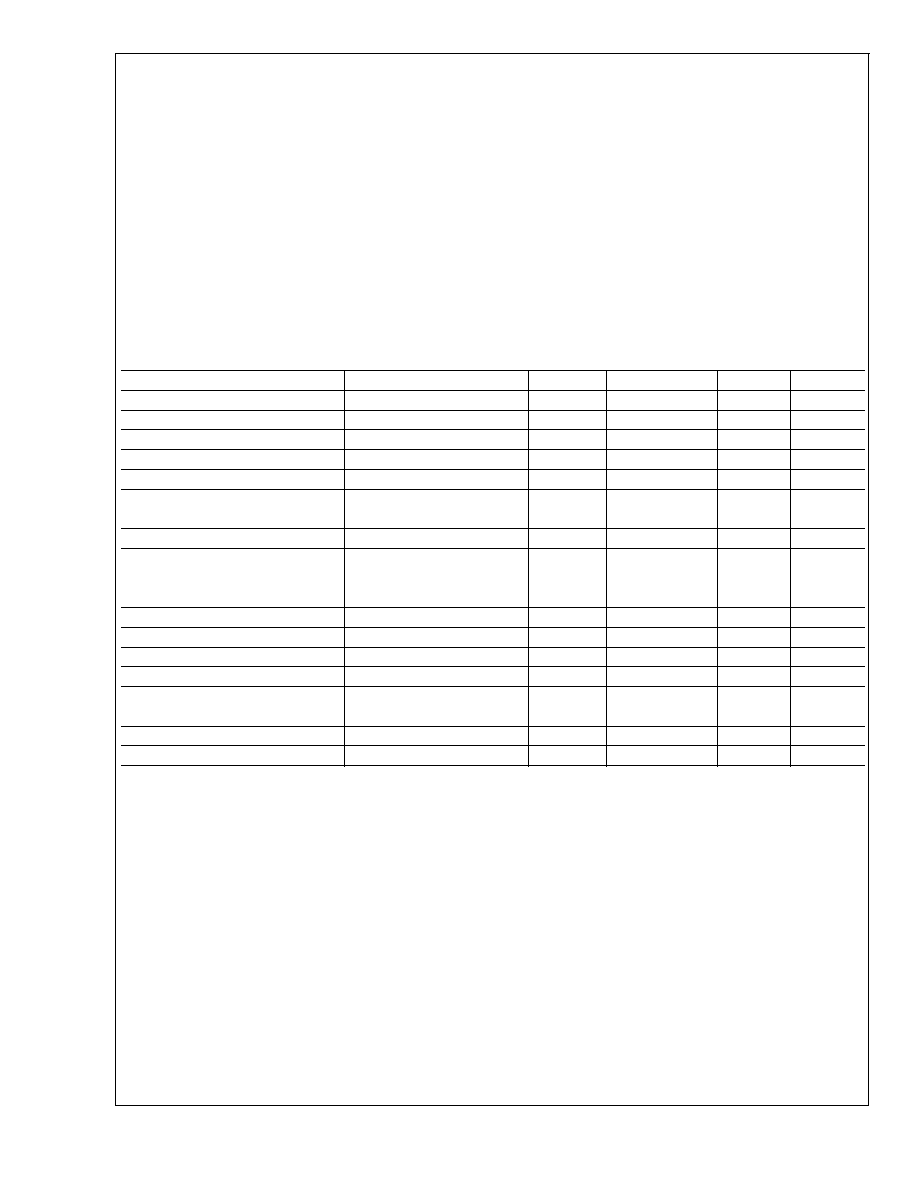
5.0 Absolute Maximum Ratings for
the LM311
(Note 12)
If Military/Aerospace specified devices are required,
please contact the National Semiconductor Sales Office/
Distributors for availability and specifications.
Total Supply Voltage (V
84
)
36V
Output to Negative Supply Voltage (V
74
)
40V
Ground to Negative Supply Voltage (V
14
)
30V
Differential Input Voltage
±
30V
Input Voltage (Note 13)
±
15V
Power Dissipation (Note 14)
500 mW
ESD Rating (Note 19)
300V
Output Short Circuit Duration
10 sec
Operating Temperature Range
0∞ to 70∞C
Storage Temperature Range
-65∞C to 150∞C
Lead Temperature (soldering, 10 sec)
260∞C
Voltage at Strobe Pin
V
+
-5V
Soldering Information
Dual-In-Line Package
Soldering (10 seconds)
260∞C
Small Outline Package
Vapor Phase (60 seconds)
215∞C
Infrared (15 seconds)
220∞C
See AN-450 "Surface Mounting Methods and Their Effect
on Product Reliability" for other methods of soldering
surface mount devices.
Electrical Characteristics
(Note 15)
for the LM311
Parameter
Conditions
Min
Typ
Max
Units
Input Offset Voltage (Note 16)
T
A
=25∞C, R
S
50k
2.0
7.5
mV
Input Offset Current(Note 16)
T
A
=25∞C
6.0
50
nA
Input Bias Current
T
A
=25∞C
100
250
nA
Voltage Gain
T
A
=25∞C
40
200
V/mV
Response Time (Note 17)
T
A
=25∞C
200
ns
Saturation Voltage
V
IN
-10 mV, I
OUT
=50 mA
0.75
1.5
V
T
A
=25∞C
Strobe ON Current (Note 18)
T
A
=25∞C
2.0
5.0
mA
Output Leakage Current
V
IN
10 mV, V
OUT
=35V
T
A
=25∞C, I
STROBE
=3 mA
0.2
50
nA
V
-
= Pin 1 = -5V
Input Offset Voltage (Note 16)
R
S
50K
10
mV
Input Offset Current (Note 16)
70
nA
Input Bias Current
300
nA
Input Voltage Range
-14.5
13.8,-14.7
13.0
V
Saturation Voltage
V
+
4.5V, V
-
=0
0.23
0.4
V
V
IN
-10 mV, I
OUT
8 mA
Positive Supply Current
T
A
=25∞C
5.1
7.5
mA
Negative Supply Current
T
A
=25∞C
4.1
5.0
mA
Note 12: "Absolute Maximum Ratings indicate limits beyond which damage to the device may occur. Operating Ratings indicate conditions for which the device is
functional, but do not guarantee specific performance limits."
Note 13: This rating applies for
±
15V supplies. The positive input voltage limit is 30V above the negative supply. The negative input voltage limit is equal to the
negative supply voltage or 30V below the positive supply, whichever is less.
Note 14: The maximum junction temperature of the LM311 is 110∞C. For operating at elevated temperature, devices in the H08 package must be derated based
on a thermal resistance of 165∞C/W, junction to ambient, or 20∞C/W, junction to case. The thermal resistance of the dual-in-line package is 100∞C/W, junction to
ambient.
Note 15: These specifications apply for V
S
=
±
15V and Pin 1 at ground, and 0∞C
<
T
A
<
+70∞C, unless otherwise specified. The offset voltage, offset current and
bias current specifications apply for any supply voltage from a single 5V supply up to
±
15V supplies.
Note 16: The offset voltages and offset currents given are the maximum values required to drive the output within a volt of either supply with 1 mA load. Thus, these
parameters define an error band and take into account the worst-case effects of voltage gain and R
S
.
Note 17: The response time specified (see definitions) is for a 100 mV input step with 5 mV overdrive.
Note 18: This specification gives the range of current which must be drawn from the strobe pin to ensure the output is properly disabled. Do not short the strobe
pin to ground; it should be current driven at 3 to 5 mA.
Note 19: Human body model, 1.5 k
in series with 100 pF.
LM1
1
1/LM21
1/LM31
1
www.national.com
4

6.0 LM111/LM211 Typical Performance Characteristics
Input Bias Current
DS005704-43
Input Bias Current
DS005704-44
Input Bias Current
DS005704-45
Input Bias Current
DS005704-46
Input Bias Current
DS005704-47
Input Bias Current
DS005704-48
LM1
1
1/LM21
1/LM31
1
www.national.com
5

6.0 LM111/LM211 Typical Performance Characteristics
(Continued)
Input Bias Current
Input Overdrives
DS005704-49
Input Bias Current
Input Overdrives
DS005704-50
Input Bias Current
DS005704-51
Response Time for Various
Input Overdrives
DS005704-52
Response Time for Various
Input Overdrives
DS005704-53
Output Limiting Characteristics
DS005704-54
LM1
1
1/LM21
1/LM31
1
www.national.com
6
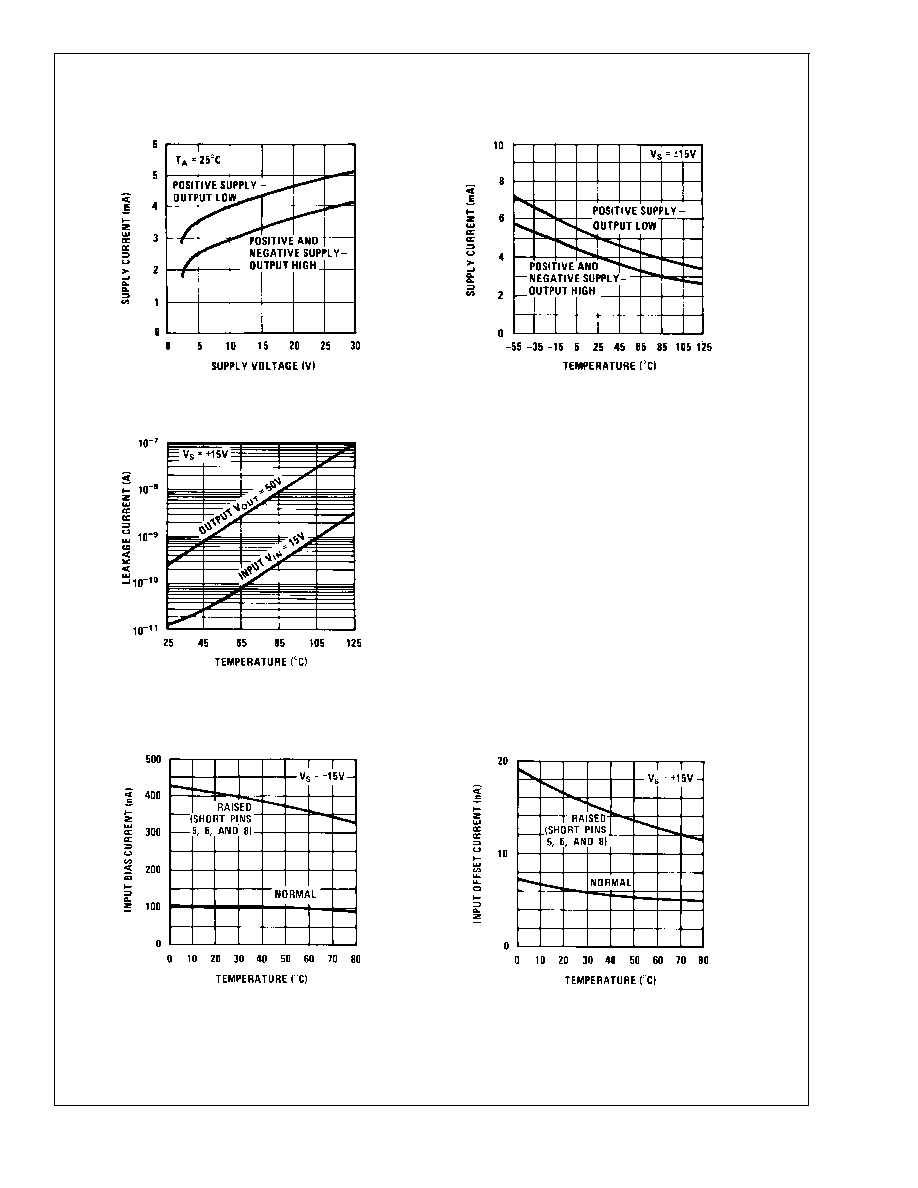
6.0 LM111/LM211 Typical Performance Characteristics
(Continued)
7.0 LM311 Typical Performance Characteristics
Supply Current
DS005704-55
Supply Current
DS005704-56
Leakage Currents
DS005704-57
Input Bias Current
DS005704-58
Input Offset Current
DS005704-59
LM1
1
1/LM21
1/LM31
1
www.national.com
7

7.0 LM311 Typical Performance Characteristics
(Continued)
Offset Error
DS005704-60
Input Characteristics
DS005704-61
Common Mode Limits
DS005704-62
Transfer Function
DS005704-63
Response Time for Various
Input Overdrives
DS005704-64
Response Time for Various
Input Overdrives
DS005704-65
LM1
1
1/LM21
1/LM31
1
www.national.com
8

7.0 LM311 Typical Performance Characteristics
(Continued)
Output Saturation Voltage
DS005704-66
Response Time for Various
Input Overdrives
DS005704-67
Response Time for Various
Input Overdrives
DS005704-68
Output Limiting Characteristics
DS005704-69
Supply Current
DS005704-70
Supply Current
DS005704-71
LM1
1
1/LM21
1/LM31
1
www.national.com
9

7.0 LM311 Typical Performance Characteristics
(Continued)
8.0 Application Hints
8.1 CIRCUIT TECHNIQUES FOR AVOIDING
OSCILLATIONS IN COMPARATOR APPLICATIONS
When a high-speed comparator such as the LM111 is used
with fast input signals and low source impedances, the out-
put response will normally be fast and stable, assuming that
the power supplies have been bypassed (with 0.1 µF disc
capacitors), and that the output signal is routed well away
from the inputs (pins 2 and 3) and also away from pins 5 and
6.
However, when the input signal is a voltage ramp or a slow
sine wave, or if the signal source impedance is high (1 k
to
100 k
), the comparator may burst into oscillation near the
crossing-point. This is due to the high gain and wide band-
width of comparators like the LM111. To avoid oscillation or
instability in such a usage, several precautions are recom-
mended, as shown in
Figure 1 below.
1.
The trim pins (pins 5 and 6) act as unwanted auxiliary
inputs. If these pins are not connected to a trim-pot, they
should be shorted together. If they are connected to a
trim-pot, a 0.01 µF capacitor C1 between pins 5 and 6
will minimize the susceptibility to AC coupling. A smaller
capacitor is used if pin 5 is used for positive feedback as
in
Figure 1.
2.
Certain sources will produce a cleaner comparator out-
put waveform if a 100 pF to 1000 pF capacitor C2 is
connected directly across the input pins.
3.
When the signal source is applied through a resistive
network, R
S
, it is usually advantageous to choose an R
S
'
of substantially the same value, both for DC and for
dynamic (AC) considerations. Carbon, tin-oxide, and
metal-film resistors have all been used successfully in
comparator input circuitry. Inductive wirewound resistors
are not suitable.
4.
When comparator circuits use input resistors (eg. sum-
ming resistors), their value and placement are particu-
larly important. In all cases the body of the resistor
should be close to the device or socket. In other words
there should be very little lead length or printed-circuit
foil run between comparator and resistor to radiate or
pick up signals. The same applies to capacitors, pots,
etc. For example, if R
S
=10 k
, as little as 5 inches of
lead between the resistors and the input pins can result
in oscillations that are very hard to damp. Twisting these
input leads tightly is the only (second best) alternative to
placing resistors close to the comparator.
5.
Since feedback to almost any pin of a comparator can
result in oscillation, the printed-circuit layout should be
engineered thoughtfully. Preferably there should be a
groundplane under the LM111 circuitry, for example, one
side of a double-layer circuit card. Ground foil (or, posi-
tive supply or negative supply foil) should extend be-
tween the output and the inputs, to act as a guard. The
foil connections for the inputs should be as small and
compact as possible, and should be essentially sur-
rounded by ground foil on all sides, to guard against
capacitive coupling from any high-level signals (such as
the output). If pins 5 and 6 are not used, they should be
shorted together. If they are connected to a trim-pot, the
trim-pot should be located, at most, a few inches away
from the LM111, and the 0.01 µF capacitor should be
installed. If this capacitor cannot be used, a shielding
printed-circuit foil may be advisable between pins 6 and
7. The power supply bypass capacitors should be lo-
cated within a couple inches of the LM111. (Some other
comparators require the power-supply bypass to be lo-
cated immediately adjacent to the comparator.)
6.
It is a standard procedure to use hysteresis (positive
feedback) around a comparator, to prevent oscillation,
and to avoid excessive noise on the output because the
comparator is a good amplifier for its own noise. In the
circuit of
Figure 2, the feedback from the output to the
positive input will cause about 3 mV of hysteresis. How-
ever, if R
S
is larger than 100
, such as 50 k
, it would
not be reasonable to simply increase the value of the
positive feedback resistor above 510 k
. The circuit of
Figure 3 could be used, but it is rather awkward. See the
notes in paragraph 7 below.
Leakage Currents
DS005704-72
LM1
1
1/LM21
1/LM31
1
www.national.com
10

8.0 Application Hints
(Continued)
7.
When both inputs of the LM111 are connected to active
signals, or if a high-impedance signal is driving the
positive input of the LM111 so that positive feedback
would be disruptive, the circuit of
Figure 1 is ideal. The
positive feedback is to pin 5 (one of the offset adjust-
ment pins). It is sufficient to cause 1 to 2 mV hysteresis
and sharp transitions with input triangle waves from a
few Hz to hundreds of kHz. The positive-feedback signal
across the 82
resistor swings 240 mV below the posi-
tive supply. This signal is centered around the nominal
voltage at pin 5, so this feedback does not add to the
V
OS
of the comparator. As much as 8 mV of V
OS
can be
trimmed out, using the 5 k
pot and 3 k
resistor as
shown.
8.
These application notes apply specifically to the LM111,
LM211, LM311, and LF111 families of comparators, and
are applicable to all high-speed comparators in general,
(with the exception that not all comparators have trim
pins).
DS005704-29
Pin connections shown are for LM111H in the H08 hermetic package
FIGURE 1. Improved Positive Feedback
DS005704-30
Pin connections shown are for LM111H in the H08 hermetic package
FIGURE 2. Conventional Positive Feedback
LM1
1
1/LM21
1/LM31
1
www.national.com
11
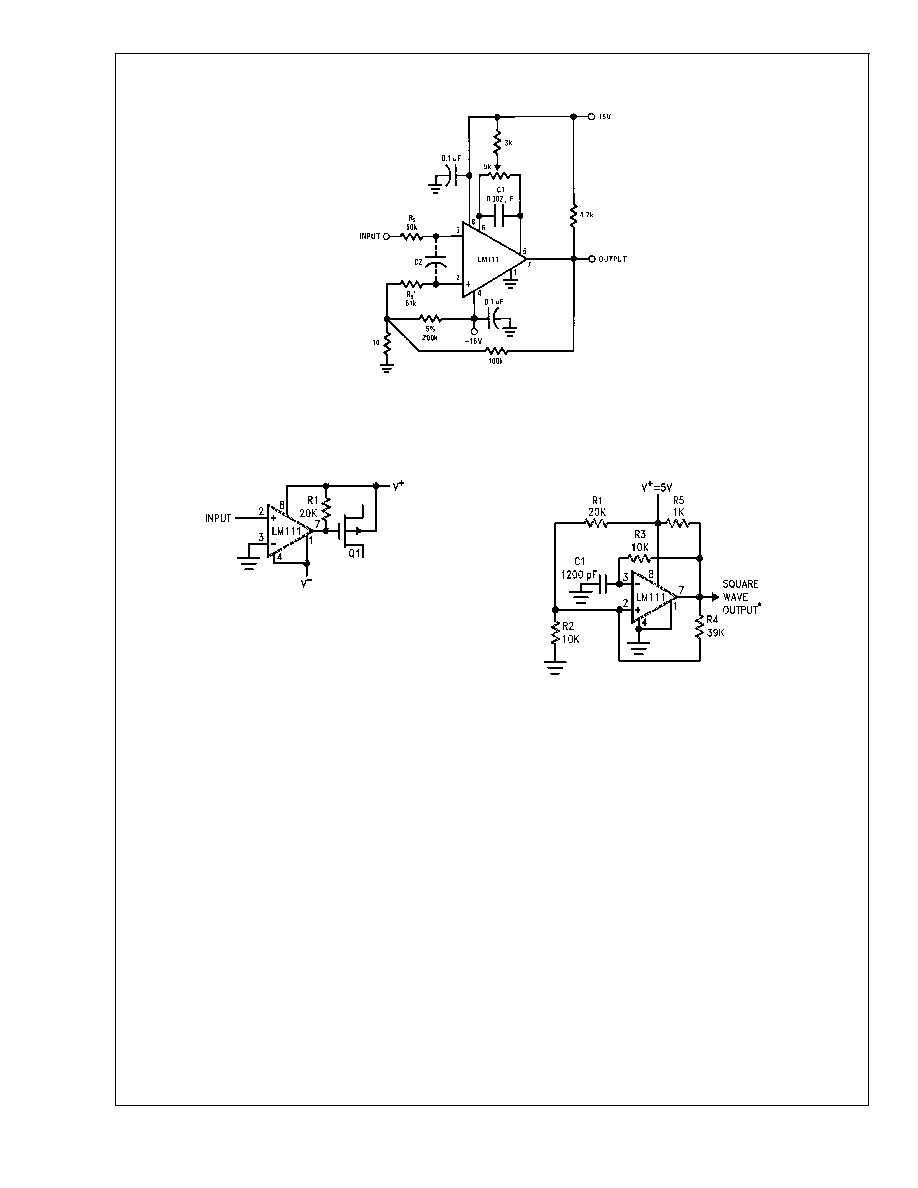
8.0 Application Hints
(Continued)
9.0 Typical Applications
(Pin numbers refer to H08 package)
DS005704-31
FIGURE 3. Positive Feedback with High Source Resistance
Zero Crossing Detector Driving MOS Switch
DS005704-13
100 kHz Free Running Multivibrator
DS005704-14
*TTL or DTL fanout of two
LM1
1
1/LM21
1/LM31
1
www.national.com
12

9.0 Typical Applications
(Pin numbers refer to H08 package) (Continued)
10 Hz to 10 kHz Voltage Controlled Oscillator
DS005704-15
*Adjust for symmetrical square wave time when V
IN
= 5 mV
Minimum capacitance 20 pF Maximum frequency 50 kHz
Driving Ground-Referred Load
DS005704-16
*Input polarity is reversed when using pin 1 as output.
Using Clamp Diodes to Improve Response
DS005704-17
TTL Interface with High Level Logic
DS005704-18
*Values shown are for a 0 to 30V logic swing and a 15V threshold.
May be added to control speed and reduce susceptibility to noise spikes.
LM1
1
1/LM21
1/LM31
1
www.national.com
13

9.0 Typical Applications
(Pin numbers refer to H08 package) (Continued)
Crystal Oscillator
DS005704-19
Comparator and Solenoid Driver
DS005704-20
Precision Squarer
DS005704-21
*Solid tantalum
Adjust to set clamp level
LM1
1
1/LM21
1/LM31
1
www.national.com
14

9.0 Typical Applications
(Pin numbers refer to H08 package) (Continued)
Low Voltage Adjustable Reference Supply
DS005704-22
*Solid tantalum
Positive Peak Detector
DS005704-23
*Solid tantalum
Zero Crossing Detector Driving MOS Logic
DS005704-24
Negative Peak Detector
DS005704-25
*Solid tantalum
LM1
1
1/LM21
1/LM31
1
www.national.com
15
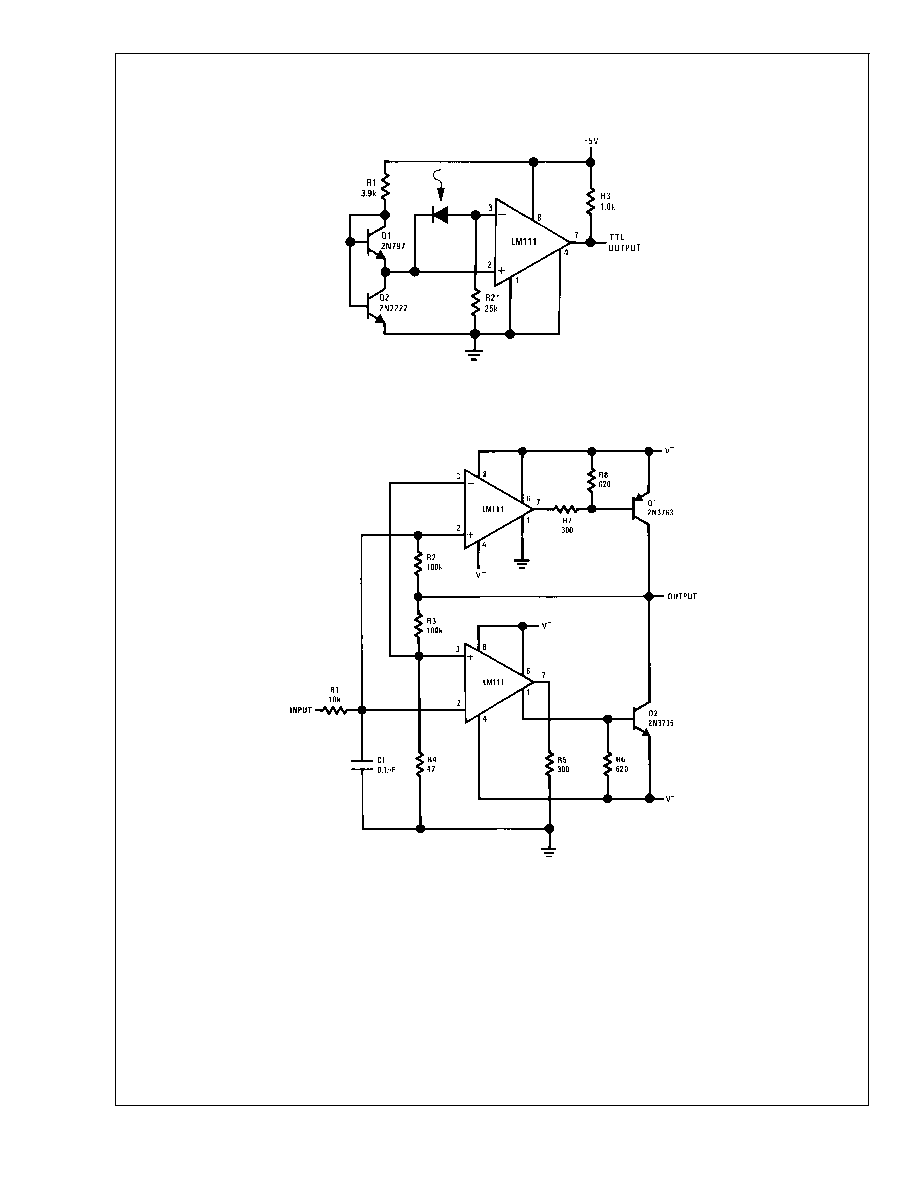
9.0 Typical Applications
(Pin numbers refer to H08 package) (Continued)
Precision Photodiode Comparator
DS005704-26
*R2 sets the comparison level. At comparison, the photodiode has less than 5 mV across it, decreasing leakages by an order of magnitude.
Switching Power Amplifier
DS005704-27
LM1
1
1/LM21
1/LM31
1
www.national.com
16
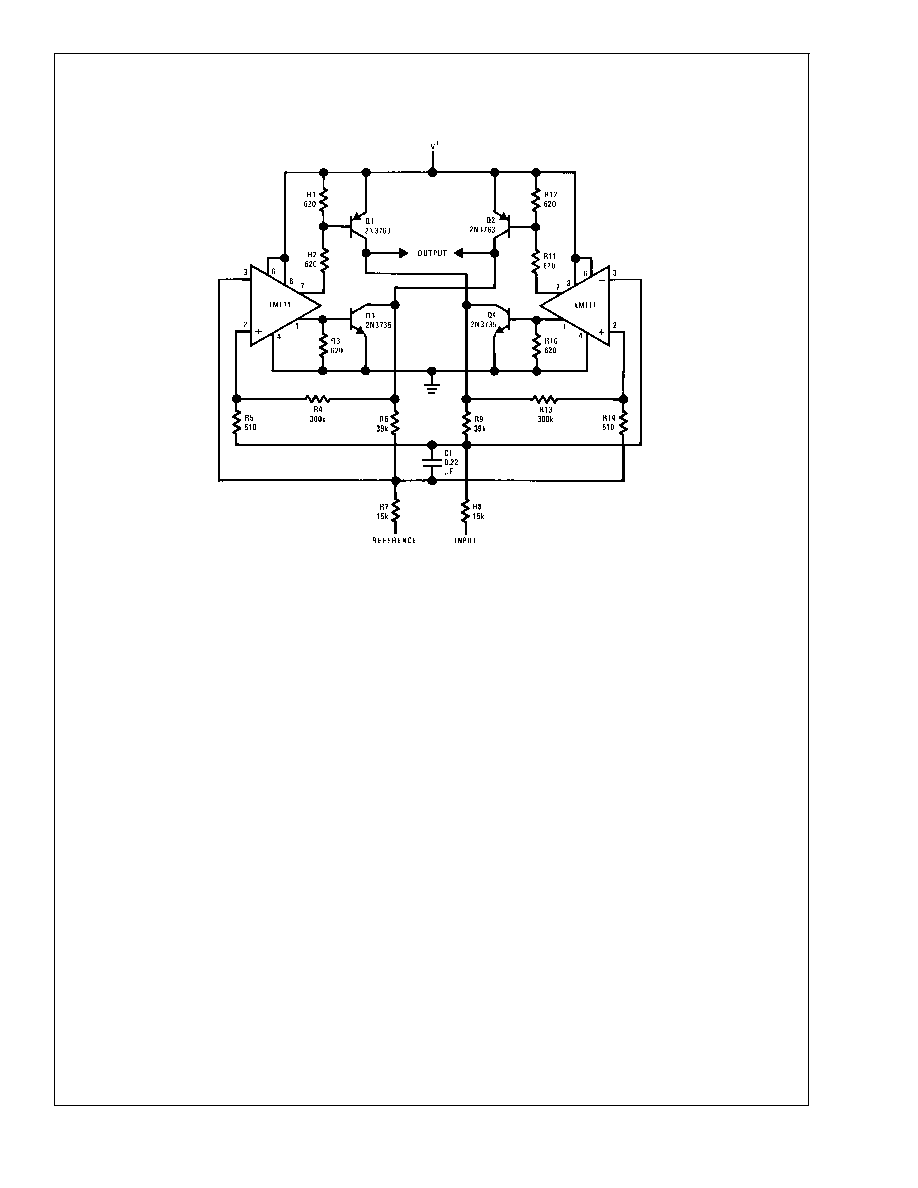
9.0 Typical Applications
(Pin numbers refer to H08 package) (Continued)
Switching Power Amplifier
DS005704-28
LM1
1
1/LM21
1/LM31
1
www.national.com
17

10.0 Schematic Diagram
(Note 20)
DS005704-5
Note 20: Pin connections shown on schematic diagram are for H08 package.
LM1
1
1/LM21
1/LM31
1
www.national.com
18

11.0 Connection Diagrams
Note 21: Also available per JM38510/10304
Metal Can Package
DS005704-6
Note: Pin 4 connected to case
Top View
Order Number LM111H, LM111H/883(Note 21) , LM211H or LM311H
See NS Package Number H08C
Dual-In-Line Package
DS005704-34
Top View
Order Number LM111J-8, LM111J-8/883(Note 21),
LM311M, LM311MX or LM311N
See NS Package Number J08A, M08A or N08E
Dual-In-Line Package
DS005704-35
Top View
Order Number LM111J/883(Note 21)
See NS Package Number J14A or N14A
DS005704-33
Order Number LM111W/883(Note 21), LM111WG/883
See NS Package Number W10A, WG10A
LM1
1
1/LM21
1/LM31
1
www.national.com
19

12.0 Physical Dimensions
inches (millimeters) unless otherwise noted
Metal Can Package (H)
Order Number LM111H, LM111H/883, LM211H or LM311H
NS Package Number H08C
Cavity Dual-In-Line Package (J)
Order Number LM111J-8, LM111J-8/883
NS Package Number J08A
LM1
1
1/LM21
1/LM31
1
www.national.com
20

12.0 Physical Dimensions
inches (millimeters) unless otherwise noted (Continued)
Dual-In-Line Package (J)
Order Number LM111J/883
NS Package Number J14A
Dual-In-Line Package (M)
Order Number LM311M, LM311MX
NS Package Number M08A
LM1
1
1/LM21
1/LM31
1
www.national.com
21
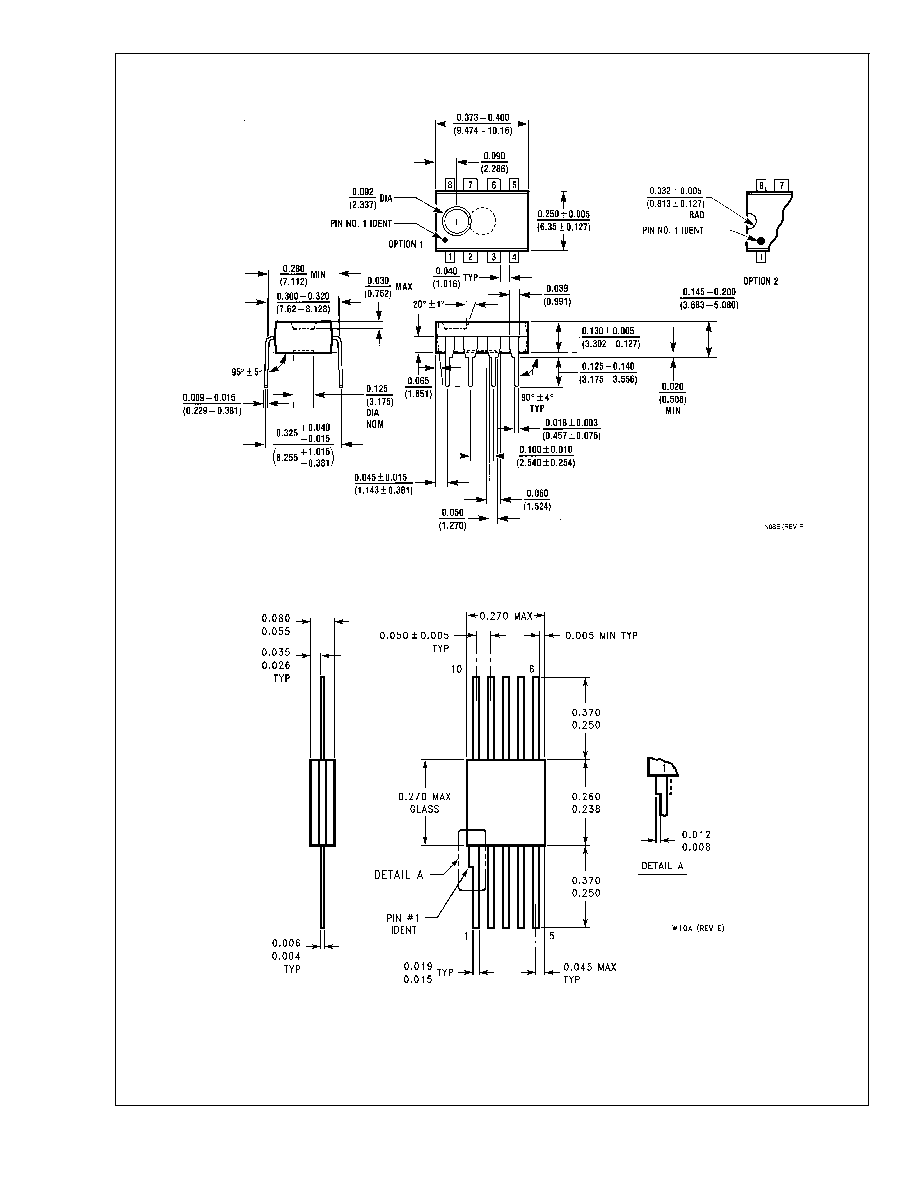
12.0 Physical Dimensions
inches (millimeters) unless otherwise noted (Continued)
Dual-In-Line Package (N)
Order Number LM311N
NS Package Number N08E
Order Number LM111W/883, LM111WG/883
NS Package Number W10A, WG10A
LM1
1
1/LM21
1/LM31
1
www.national.com
22

Notes
LIFE SUPPORT POLICY
NATIONAL'S PRODUCTS ARE NOT AUTHORIZED FOR USE AS CRITICAL COMPONENTS IN LIFE SUPPORT
DEVICES OR SYSTEMS WITHOUT THE EXPRESS WRITTEN APPROVAL OF THE PRESIDENT AND GENERAL
COUNSEL OF NATIONAL SEMICONDUCTOR CORPORATION. As used herein:
1. Life support devices or systems are devices or
systems which, (a) are intended for surgical implant
into the body, or (b) support or sustain life, and
whose failure to perform when properly used in
accordance with instructions for use provided in the
labeling, can be reasonably expected to result in a
significant injury to the user.
2. A critical component is any component of a life
support device or system whose failure to perform
can be reasonably expected to cause the failure of
the life support device or system, or to affect its
safety or effectiveness.
National Semiconductor
Corporation
Americas
Tel: 1-800-272-9959
Fax: 1-800-737-7018
Email: support@nsc.com
National Semiconductor
Europe
Fax: +49 (0) 180-530 85 86
Email: europe.support@nsc.com
Deutsch Tel: +49 (0) 69 9508 6208
English
Tel: +44 (0) 870 24 0 2171
FranÁais Tel: +33 (0) 1 41 91 8790
National Semiconductor
Asia Pacific Customer
Response Group
Tel: 65-2544466
Fax: 65-2504466
Email: ap.support@nsc.com
National Semiconductor
Japan Ltd.
Tel: 81-3-5639-7560
Fax: 81-3-5639-7507
www.national.com
LM1
1
1/LM21
1/LM31
1
V
oltage
Comparator
National does not assume any responsibility for use of any circuitry described, no circuit patent licenses are implied and National reserves the right at any time without notice to change said circuitry and specifications.






















